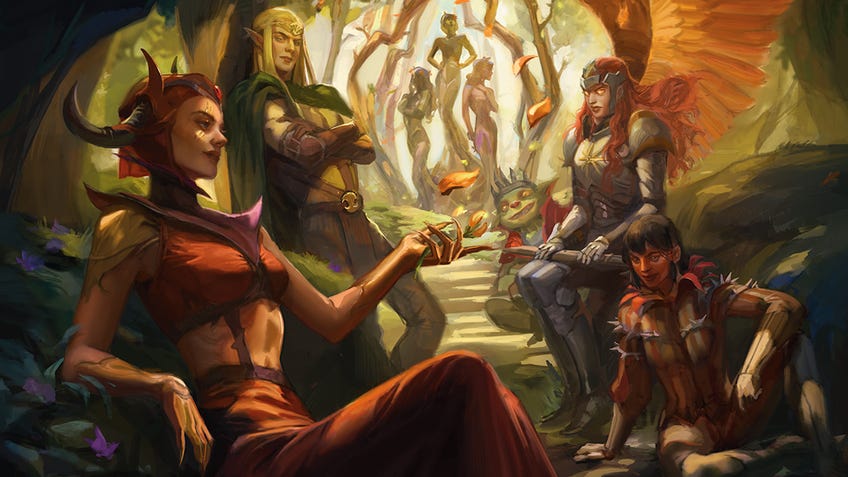How to draft Magic: The Gathering’s Murders at Karlov Manor
A beginner’s guide to Ravnican detective work across 10 dual-colour archetypes.
Magic: The Gathering returns once again to the fan-favourite plane of Ravnica for another set - Murders at Karlov Manor. This time we aren’t meddling in Guildpact business or attempting to defeat dragon-turned-god despot Nicol Bolas. No, we’re all strapping on our thinking caps and playing detective by solving cases, collecting evidence and donning disguises.
Players will get their first taste of Murders at Karlov Manor’s draft scene at prerelease events starting February 2nd and running through the weekend, so we thought it would be nice to quickly run down the dominant strategies and offer some tips on deck-building. This guide is for beginners and the draft curious, but even more seasoned pack crackers might find some reminders worth scribbling down in their gumshoe notebooks.
First, some basics: there are ten major archetypes across ten dual-coloured Mana pairs, and each contains one or two uncommon rarity cards called ‘signpost Uncommons’ that will immediately switch on your strategy and form the core of your deck’s engine. Always be on the lookout for big and impactful ‘bomb rares’, but choosing one of these ten strategies with plenty of open cards at your table is a much more reliable path to victory.
Blue/White: Detectives
Signpost Uncommon - Private Eye
Azorious (Blue/White) presents one of the most straightforward archetype because it simply wants you to play as many Detective creatures in its two colours as possible. The set includes 24 of these in Blue/White and another 16 in other colours (if you fancy a cheeky splash), so it shouldn’t be difficult to amass your own agency. I’d recommend attacking often and using Azorius’ trademark removal and counterspells to keep the battlefield clear, and always nab Detectives-matter cards such as Thinking Cap and Case of the Pilfered Proof.
Blue/Black: Clues Control
Signpost Uncommon - Curious Cadaver
Dimir (Blue/Black) presents a decidedly less thematic archetype that will prove harder to build if you don’t know what to look for - mostly good removal spells, 2-for-1 trades and anything that will grind the game out. Spells such as Out Cold put your opponent on ice (sorry) while granting you some free resources, while Faerie Snoop’s card advantage and chunky flyer status makes it a fantastic way to slowly win you games in the air.
Black/Red: Suspect Aggro
Signpost Uncommons - Rune-Brand Juggler and Deadly Complication
Rakdos (Black/Red) really likes pointing the finger at anyone they suspect could be a murderer - and the Rakdos Guild kills a tonne of people. That means you’ll be making liberal use of the new Suspect mechanic, which gives a creature menace but also keeps them from blocking. While you’ll be tempted to stymie an opponent’s beefy blocker, it can be just as effective on a cheap and quick creature of your own. Run cheap threats and creatures with haste such as Repeat Offender and Red Herring to keep the pressure high.

Red/Green: Big Disguise
Signpost Uncommon - Tin Street Gossip
Gruul’s (Red/Green) strategy relies on cheap, Mana-producing creatures (called ‘mana dorks) arriving early to lay out the carpet for larger threats disguised as 2/2 face-down creatures. Riftburst Hellion is the perfect example of a threat literally bursting out of the ground at the most inconvenient moment for your opponent. This strategy is ambitious and won’t switch on until a little later in the game, so don’t over-invest in tiny producers or skip defensive spells.
Green/White: Go-Wide Disguise
Signpost Uncommon - Sumala Sentry
The second archetype that cares about Disguised creatures, Selesneya (Green/White) actually just needs a bunch of small bodies choking up your side of the board and waiting for combat tricks such as On the Job or Greenbelt Radical to transform your weenies into warriors. Savvy drafters will note that White also shares the Battalion archetype with Red (more on that in a tic), and thus rewards snagging anything that triggers when “three or more creatures attack”. Build up, combat trick, turn sideways for the victory. Easy as.
Black/White: Pint-Size Disguise
Signpost Uncommon - Wispdrinker Vampire
Orzhov (Black/White) will also truck in ‘weenie’ creatures with two or less power, whether that’s face-down Disguised threats or other small fries. But instead of a ball of hate, this strategy uses them to activate other effects such as the aforementioned Wispdrinker Vampire, Neighborhood Guardian or Slimy Dualleech. Decks in these colours can struggle against massive walls of toughness, so be sure to grab some instants or sorceries that will let you slip through the cracks, or else make your opponent think twice about chump blocking.
Blue/Red: Artefact Sacrifice
Signpost Uncommons - Gleaming Geardrake and Detective’s Satchel
Izzet (Blue/Red) players enjoy yet another fairly simple use of their archetype, in that they will create artefacts through various means and then use them as fuel through other various means. How you create and destroy is up to you, and there are plenty of cards that plug in to both sides of this equation. Reminder: Clues tokens count as artefacts, so perhaps think twice about immediately cracking them for the card draw.
Black/Green: Gravebreak
Signpost Uncommons - Kraul Whipcracker and Insidious Roots
Golgari’s (Black/Green) archetype is better understood as ‘creatures leaving the graveyard’, as that’s the trigger you’ll want to be activating every turn. These decks will want to run plenty of creatures to avoid running out of fuel late in the game, and smart players won’t light every fuse at the same time. The ‘yard is a resource and should be used wisely. Activation comes from any Collect Evidence effect but also cards such as Macabre Reconstruction and Rubblebelt Maverick.
Red/White: Battalion
Signpost Uncommon - Meddling Youths
Boros (Red/White) plays a familiar tune with an archetype that rewards attacking your opponent early and often with three or more creatures. As mentioned above, this unofficial battalion keyword means prioritising cheap, quick creatures such as Seasoned Consultant and keeping your mana curve away from too many cards larger than your Scooby Doo-lampooning signpost uncommon. Haste will be your best friend for triggering battalion out of the blue, but removal-heavy decks might shatter the glass cannon nature of this strategy.
Blue/Green: Collect Evidence
Signpost Uncommon - Evidence Examiner
Ah, Simic (Blue/Green). This colour pair often suffers a lack of coherent strategy in the draft format and relies on dipping into other archetypes for support. Murders at Karlov Manor proves no different - you will need cards that fill your graveyard and Collect Evidence to make the most out of Simic’s strategy. Quality instant and sorceries can keep your hand stocked while also immediately providing fodder for evidence collecting, which will trigger cards such as Surveillance Monitor. Play this strategy if you aren’t afraid of dipping your toe into Black’s cards to bolster your forces.









